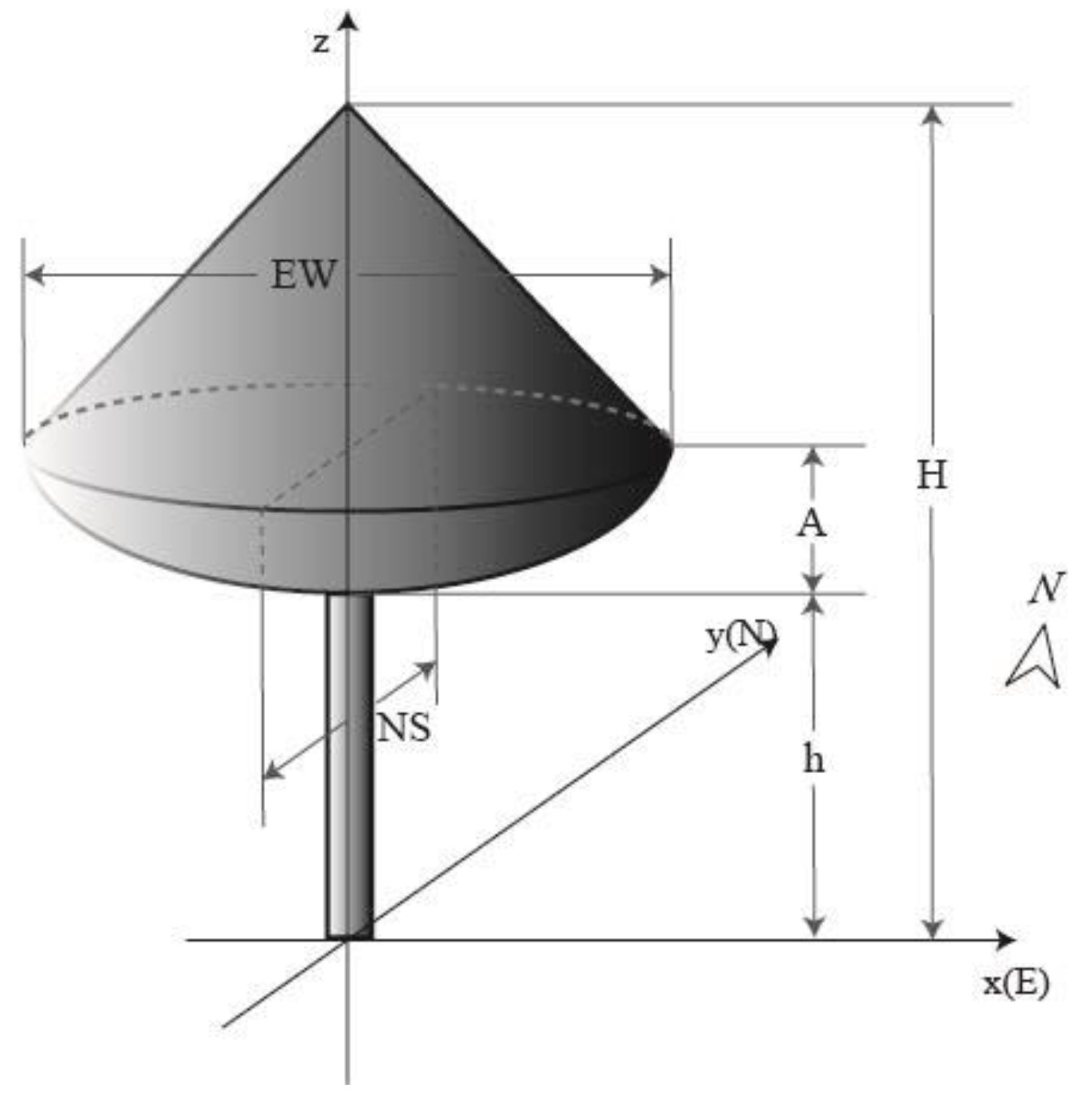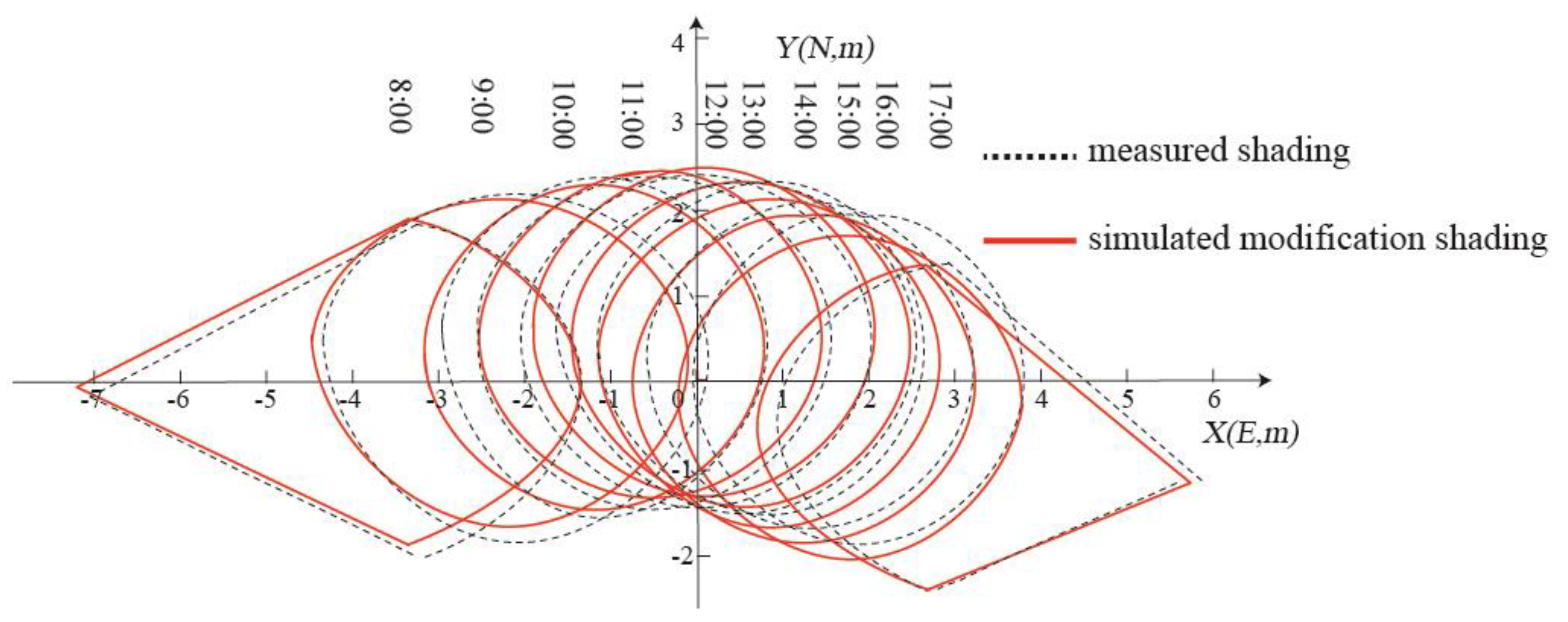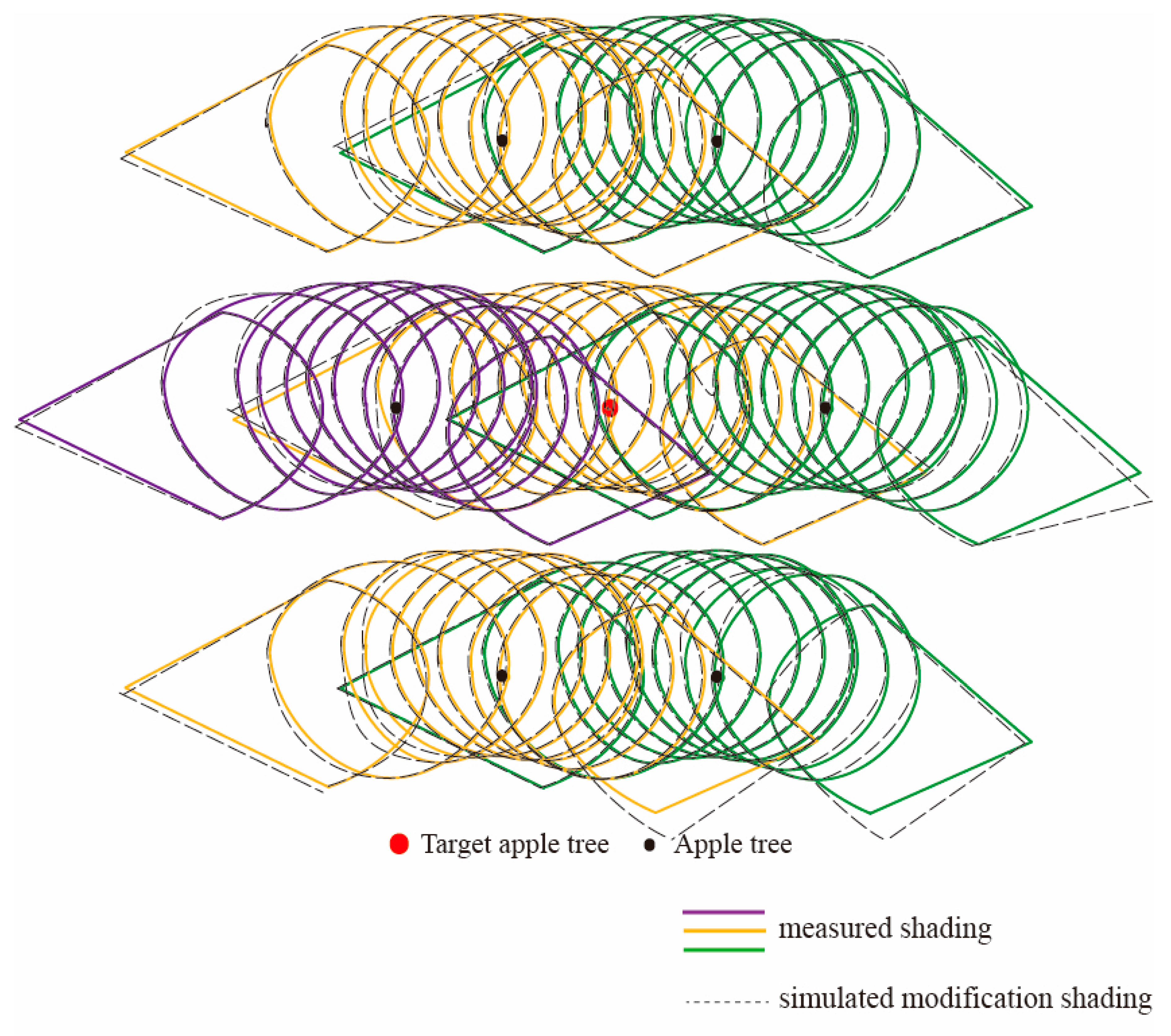The Improved Canopy Shading Model Based on the Apple Intercropping System (Case Study: Loess Plateau, China)
Abstract
1. Introduction
2. Materials and Methods
2.1. Study Area
2.2. Materials and Experimental Design
2.2.1. The Construction of the Model of an Apple Tree
2.2.2. Shade Distribution
2.2.3. The Improvement of the Canopy Shading Model for the Apple Tree
2.2.4. Shading Distribution of Apple Trees under the Conventional Arrangement
3. Results
3.1. Simulation Accuracy of the Canopy Shading Model
3.2. The Improvement of the Canopy Shading Model for Apple Trees
3.3. Applicability Analysis of the Improved Canopy Shading Model
4. Discussion
5. Conclusions
Author Contributions
Funding
Acknowledgments
Conflicts of Interest
Appendix A








| Measurement | Apple Tree | 3D Model (1/50) | |
|---|---|---|---|
| Crown breadth | North and south (NS)/m | 4.192 | 0.084 |
| East and west (EW)/m | 4.001 | 0.080 | |
| Tree height (H)/m | 3.486 | 0.070 | |
| Height of tree trunk (h)/m | 0.752 | 0.015 | |
| Height under Crown breadth (A)/m | 0.883 | 0.018 | |
| Time | 8:00 | 9:00 | 10:00 | 11:00 | 12:00 | 13:00 | 14:00 | 15:00 | 16:00 | 17:00 |
|---|---|---|---|---|---|---|---|---|---|---|
| Before improved | 72.63 | 80.02 | 89.90 | 91.24 | 94.02 | 92.14 | 88.51 | 86.12 | 78.76 | 84.00 |
| After improved | 94.12 | 95.17 | 95.32 | 96.22 | 97.00 | 97.13 | 95.56 | 96.41 | 95.31 | 95.01 |
References
- Mbow, C.; Van Noordwijk, M.; Luedeling, E.; Neufeldt, H.; Minang, P.A.; Kowero, G. Agroforestry solutions to address food security and climate change challenges in Africa. Curr. Opin. Environ. Sustain. 2014, 6, 61–67. [Google Scholar] [CrossRef]
- Cao, F.L.; Kimmins, J.P.; Wang, J.R. Competitive interactions in Ginkgo and crop species mixed agroforestry systems in Jiangsu, China. Agrofor. Syst. 2012, 84, 401–415. [Google Scholar] [CrossRef]
- Santiago-Freijanes, J.J.; Pisanelli, A.; Rois-Díaz, M.; Aldrey-Vázquez, J.A.; Rigueiro-Rodríguez, A.; Pantera, A.; Vityi, A.; Lojka, B.; Ferreiro-Domínguez, N.; Mosquera-Losada, M.R. Agroforestry development in Europe: Policy issues. Land Use Policy 2018, 76, 144–156. [Google Scholar] [CrossRef]
- Benjamin, E.O.; Ola, O.; Buchenrieder, G. Does an agroforestry scheme with payment for ecosystem services (PES) economically empower women in sub-Saharan Africa? Ecosyst. Serv. 2018, 31, 1–11. [Google Scholar] [CrossRef]
- Escribano, M.; Diaz-Caro, C.; Mesias, F.J. A participative approach to develop sustainability indicators for dehesa agroforestry farms. Sci. Total Environ. 2018, 640–641, 89–97. [Google Scholar] [CrossRef] [PubMed]
- Torralba, M.; Fagerholm, N.; Burgess, P.J.; Moreno, G.; Plieninger, T. Do European agroforestry systems enhance biodiversity and ecosystem services? A meta-analysis. Agric. Ecosyst. Environ. 2016, 230, 150–161. [Google Scholar] [CrossRef]
- Calfapietra, C.; Gielen, B.; Karnosky, D.; Ceulemans, R.; Scarascia Mugnozza, G. Response and potential of agroforestry crops under global change. Environ. Pollut. 2010, 158, 1095–1104. [Google Scholar] [CrossRef] [PubMed]
- Nassab, A.D.M.; Amon, T.; Kaul, H.P. Competition and yield in intercrops of maize and sunflower for biogas. Ind. Crops Prod. 2011, 34, 1203–1211. [Google Scholar] [CrossRef]
- Sun, Y.; Bi, H.; Xu, H.; Duan, H.; Peng, R.; Wang, J. Below-Ground Interspecific Competition of Appl (Malus pumila M.)–Soybean (Glycine max L. Merr.) Intercropping Systems Based on Niche Overlap on the Loess Plateau of China. Sustainability 2018, 10, 3022. [Google Scholar] [CrossRef]
- Gyau, A.; Franzel, S.; Chiatoh, M.; Nimino, G.; Owusu, K. Collective action to improve market access for smallholder producers of agroforestry products: Key lessons learned with insights from Cameroon’s experience. Curr. Opin. Environ. Sustain. 2014, 6, 68–72. [Google Scholar] [CrossRef]
- Klimek-Kopyra, A.; Zajac, T.; Rebilas, K. A mathematical model for the evaluation of cooperation and competition effects in intercrops. Eur. J. Agron. 2013, 51, 9–17. [Google Scholar] [CrossRef]
- Foster, K.; Neufeldt, H. Biocarbon projects in agroforestry: Lessons from the past for future development. Curr. Opin. Environ. Sustain. 2014, 6, 148–154. [Google Scholar] [CrossRef]
- Fagerholm, N.; Torralba, M.; Burgess, P.J.; Plieninger, T. A systematic map of ecosystem services assessments around European agroforestry. Ecol. Indic. 2016, 62, 47–65. [Google Scholar] [CrossRef]
- Cai, C.F.; Wang, F.; Ding, S.W.; Huang, L.; Hua, S.Z. Nutrients Competition and Its Action Mechanism Between Component Parts in Inter-cropping Systems and Agroforestry. Res. Soil Water Conserv. 2000, 7, 219–222. [Google Scholar] [CrossRef]
- Jia, G.M.; Zhang, P.D.; Wang, G.; Cao, J.; Han, J.C.; Huang, Y.P. Relationship Between Microbial Community and Soil Properties During Natural Succession of Abandoned Agricultural Land. Pedosphere 2010, 20, 352–360. [Google Scholar] [CrossRef]
- Ren, Y.Y.; Liu, J.J.; Wang, Z.L.; Zhang, S.Q. Planting density and sowing proportions of maize–soybean intercrops affected competitive interactions and water-use efficiencies on the Loess Plateau, China. Eur. J. Agron. 2016, 72, 70–79. [Google Scholar] [CrossRef]
- Charbonnier, F.; le Maire, G.; Dreyer, E.; Casanoves, F.; Christina, M.; Dauzat, J.; Eitel, J.U.H.; Vaast, P.; Vierling, L.A.; Roupsard, O. Competition for light in heterogeneous canopies: Application of MAESTRA to a coffee (Coffea arabica L.) agroforestry system. Agric. For. Meteorol. 2013, 181, 152–169. [Google Scholar] [CrossRef]
- Zhang, D.S.; Du, G.J.; Sun, Z.X.; Bai, W.; Wang, Q.; Feng, L.S.; Zheng, J.M.; Zhang, Z.; Liu, Y.; Yang, S.; et al. Agroforestry enables high efficiency of light capture, photosynthesis and dry matter production in a semi-arid climate. Eur. J. Agron. 2018, 94, 1–11. [Google Scholar] [CrossRef]
- Zhang, L.; van der Werf, W.; Bastiaans, L.; Zhang, S.; Li, B.; Spiertz, J.H.J. Light interception and utilization in relay intercrops of wheat and cotton. Field Crops Res. 2008, 107, 29–42. [Google Scholar] [CrossRef]
- Wang, Z.K.; Zhao, X.N.; Wu, P.T.; Gao, Y.; Yang, Q.; Shen, Y.Y. Border row effects on light interception in wheat/maize strip intercropping systems. Field Crops Res. 2017, 214, 1–13. [Google Scholar] [CrossRef]
- Zhao, W.G.; Qualls, R.J.; Berliner, P.R. Modeling of the short wave radiation distribution in an agroforestry system. Agric. For. Meteorol. 2003, 118, 185–206. [Google Scholar] [CrossRef]
- Zamora, D.S.; Jose, S.; Nair, P.K.R.; Ramsey, C.L. Interspecific competition in a pecan–cotton alleycropping system in the southern United States: Production physiology. Can. J. Bot. 2006, 84, 1686–1694. [Google Scholar] [CrossRef]
- Ramanna, L.; Rawat, I.; Bux, F. Light enhancement strategies improve microalgal biomass productivity. Renew. Sustain. Energy Rev. 2017, 80, 765–773. [Google Scholar] [CrossRef]
- Zivcak, M.; Brestic, M.; Kalaji, H.M. Photosynthetic responses of sun and shade grown barley leaves to high light: Is the lower PSII connectivity in shade leaves associated with protection against excess of light? Photosynth. Res. 2014, 119, 339–354. [Google Scholar] [CrossRef] [PubMed]
- De Casas, R.R.; Vargas, P.; Pérez-Corona, E.; Manrique, E.; García-Verdugo, C.; Balaguer, L. Sun and shade leaves of Olea europaea respond differently to plant size, light availability and genetic variation. Funct. Ecol. 2011, 25, 802–812. [Google Scholar] [CrossRef]
- Givinish, T.J. Adaptation to Sun and Shade: A Whole-plant perspective. Aust. J. Plant Physiol. 1988, 15, 63–92. [Google Scholar] [CrossRef]
- Terashima, I.; Hanba, Y.T.; Tazoe, Y.; Vyas, P.; Yano, S. Irradiance and phenotype: Comparative eco-development of sun and shade leaves in relation to photosynthetic CO2 diffusion. J. Exp. Bot. 2005, 57, 343–354. [Google Scholar] [CrossRef] [PubMed]
- Wobbe, L.; Bassi, R.; Kruse, O. Multi-level light capture control in plants and greenalgae. Trends Plant Sci. 2016, 21, 55–68. [Google Scholar] [CrossRef] [PubMed]
- Gao, L.B.; Xu, H.S.; Bi, H.X.; Xi, W.M.; Bao, B.; Wang, X.Y.; Bi, C.; Chang, Y.F. Intercropping competition between apple trees and crops in agroforestry systems on the Loess Plateau of China. PLoS ONE 2013, 8, e70739. [Google Scholar] [CrossRef] [PubMed]
- Tiwari, T.P.; Brook, R.M.; Wagstaff, P.; Sinclair, F.L. Effects of light environment on maize in hillside agroforestry systems of Nepal. Food Secur. 2012, 4, 103–114. [Google Scholar] [CrossRef]
- Annandale, J.G.; Jovanovic, N.Z.; Campbell, G.S.; Du Sautoy, N.; Lobit, P. Two-dimensional solar radiation interception model for hedgerow fruit trees. Agric. For. Meteorol. 2004, 121, 207–225. [Google Scholar] [CrossRef]
- Bellow, J.G.; Nair, P.K.R. Comparing common methods for assessing understory light availability in shaded-perennial agroforestry systems. Agric. For. Meteorol. 2003, 114, 197–221. [Google Scholar] [CrossRef]
- Alam, B.; Singh, R.; Uthappa, A.R.; Chaturvedi, M.; Singh, A.K.; Newaj, R.; Handa, A.K.; Chaturvedi, O.P. Different genotypes of Dalbergia sissoo trees modified microclimate dynamics differently on understory crop cowpea (Vigna unguiculata) as assessed through ecophysiological and spectral traits in agroforestry system. Agric. For. Meteorol. 2018, 249, 138–148. [Google Scholar] [CrossRef]
- Bertomeu, M. Growth and yield of maize and timber trees in smallholder agroforestry systems in Claveria, northern Mindanao, Philippines. Agrofor. Syst. 2011, 84, 73–87. [Google Scholar] [CrossRef]
- Keesman, K.J.; Graves, A.; van der Werf, W.; Burgess, P.J.; Palma, J.; Dupraz, C.; van Keulen, H. A system identification approach for developing and parameterising an agroforestry system model under constrained availability of data. Environ. Model. Softw. 2011, 26, 1540–1553. [Google Scholar] [CrossRef]
- Denholm, J.V. The influence of penumbra on canopy photosynthesis II. canopy of horizontal circulr leaves. Agric. Meteorol. 1981, 25. [Google Scholar] [CrossRef]
- Salazar, T.J.H. Calculation of the shadow-penumbra relation and its application on efficient architectural design. Sol. Energy 2014, 110, 139–150. [Google Scholar] [CrossRef]
- Li, S.R.; Yong, Z. Study on the shading mathmatic model of tree crown. Acta Agric. Univ. Henanensis 1994, 28, 361–366. [Google Scholar] [CrossRef]
- Talbot, G.; Dupraz, C. Simple models for light competition within agroforestry discontinuous tree stands: Are leaf clumpiness and light interception by woody parts relevant factors? Agrofor. Syst. 2011, 84, 101–116. [Google Scholar] [CrossRef]
- Adelinea, K.R.M.; Briotteta, X.; Ceamanosa, X.; Dartigalonguea, T.; Gastellu-Etchegorryc, J.P. ICARE-VEG: A 3D physics-based atmospheric correction method for treeshadows in urban areas. ISPRS J. Photogramm. Remote Sens. 2018, 142, 311–327. [Google Scholar] [CrossRef]
© 2018 by the authors. Licensee MDPI, Basel, Switzerland. This article is an open access article distributed under the terms and conditions of the Creative Commons Attribution (CC BY) license (http://creativecommons.org/licenses/by/4.0/).
Share and Cite
Wang, J.; Bi, H.; Sun, Y.; Duan, H.; Peng, R. The Improved Canopy Shading Model Based on the Apple Intercropping System (Case Study: Loess Plateau, China). Sustainability 2018, 10, 3486. https://doi.org/10.3390/su10103486
Wang J, Bi H, Sun Y, Duan H, Peng R. The Improved Canopy Shading Model Based on the Apple Intercropping System (Case Study: Loess Plateau, China). Sustainability. 2018; 10(10):3486. https://doi.org/10.3390/su10103486
Chicago/Turabian StyleWang, Jingjing, Huaxing Bi, Yubo Sun, Hangqi Duan, and Ruidong Peng. 2018. "The Improved Canopy Shading Model Based on the Apple Intercropping System (Case Study: Loess Plateau, China)" Sustainability 10, no. 10: 3486. https://doi.org/10.3390/su10103486
APA StyleWang, J., Bi, H., Sun, Y., Duan, H., & Peng, R. (2018). The Improved Canopy Shading Model Based on the Apple Intercropping System (Case Study: Loess Plateau, China). Sustainability, 10(10), 3486. https://doi.org/10.3390/su10103486





